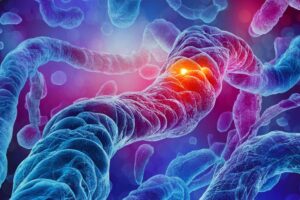Myeloid Leukemia Causes, Symptoms, Prevention and Treatments
Myeloid Leukemia, a type of blood cancer that originates in the bone marrow and blood cells, is a complex and challenging disease that affects a significant number of individuals worldwide. Understanding the causes, symptoms, and treatment options for Myeloid Leukemia is crucial for both patients and healthcare providers.
This article aims to provide a comprehensive overview of Myeloid Leukemia, exploring the various factors that contribute to its development, the telltale signs and symptoms that accompany the disease, as well as the latest advancements in diagnosis and treatment modalities.
By shedding light on the complexities of this disease, we aim to provide valuable insights on how to effectively manage and combat Myeloid Leukemia, ultimately improving outcomes and quality of life for those affected.

Table of Contents
ToggleIntroduction to Myeloid Leukemia
Myeloid leukemia is a type of cancer that affects the myeloid cells, which are a type of white blood cell responsible for fighting infections. This type of leukemia occurs when there is uncontrolled growth of abnormal myeloid cells in the bone marrow, leading to a disruption in the normal production of blood cells.
Myeloid leukemia is further classified into acute myeloid leukemia (AML) and chronic myeloid leukemia (CML) based on the rapidity of progression of the disease. AML is a fast-growing leukemia that requires immediate treatment, while CML progresses more slowly and may not require treatment right away.
The exact cause of myeloid leukemia is not fully understood, but certain risk factors have been identified, such as exposure to radiation, certain chemical substances, genetic predisposition, and certain blood disorders.
The symptoms of myeloid leukemia can vary depending on the type and stage of the disease, but common symptoms include fatigue, easy bruising or bleeding, frequent infections, and unexplained weight loss. Diagnosis of myeloid leukemia is typically made through blood tests, bone marrow biopsy, and genetic testing.
Treatment for myeloid leukemia may involve a combination of chemotherapy, targeted therapy, radiation therapy, and stem cell transplant, depending on the type and stage of the disease.
The prognosis for myeloid leukemia varies depending on factors such as the patient’s age, overall health, response to treatment, and genetic abnormalities. Advances in research and treatment options have improved outcomes for patients with myeloid leukemia in recent years, but early detection and prompt treatment are crucial for a successful outcome.
Read more about “How to Cope with Depression in LGBTQIA+ Communities?”
Types of Myeloid Leukemia
There are several types of myeloid leukemia, with the most common being acute myeloid leukemia (AML) and chronic myeloid leukemia (CML). AML is a rapidly progressing cancer that starts in the bone marrow and quickly spreads to the blood and other organs. It is characterized by an overproduction of immature myeloid cells, which can crowd out normal blood cells and lead to symptoms such as fatigue, easy bruising, and infections.
CML, on the other hand, is a slow-growing cancer that starts in the bone marrow and slowly progresses over time. It is characterized by the presence of a genetic abnormality called the Philadelphia chromosome, which leads to the overproduction of mature myeloid cells.
Another type of myeloid leukemia is myelodysplastic syndrome (MDS), which is a group of disorders that affect the production of blood cells in the bone marrow. MDS can progress to AML in some cases, making it a pre-leukemic condition. Patients with MDS may experience symptoms such as anemia, easy bruising, and infections due to a lack of healthy blood cells.
Finally, there is myeloproliferative neoplasms (MPNs), which are a group of disorders characterized by the overproduction of one or more types of blood cells in the bone marrow.
MPNs can progress to acute leukemia in some cases and may present with symptoms such as enlarged spleen, night sweats, and weight loss.
In a nutshell, myeloid leukemia encompasses a variety of diseases that affect the bone marrow and blood cells. Understanding the different types of myeloid leukemia, such as AML, CML, MDS, and MPNs, is important for accurate diagnosis and treatment.
While treatments for myeloid leukemia have advanced in recent years, further research is needed to improve outcomes for patients with this challenging disease. By increasing awareness and funding for research, we can hope to find new therapies and ultimately improve the prognosis for patients with myeloid leukemia.
Read more about “What are the Causes and Symptoms of Periodontitis and how to Treat?”
Causes of Myeloid Leukemia
The exact cause of myeloid leukemia is not fully understood, but there are several known risk factors that may increase the likelihood of developing this disease. One of the primary causes of myeloid leukemia is exposure to certain environmental toxins, such as benzene and other chemicals found in cigarette smoke and industrial settings.
These toxins can damage the DNA in bone marrow cells, leading to the development of leukemia. Additionally, genetic factors can play a role in the development of myeloid leukemia.
Certain inherited genetic mutations, such as those found in the genes responsible for cell growth and division, can increase the risk of developing leukemia.
Another contributing factor to the development of myeloid leukemia is ionizing radiation exposure.
Radiation therapy for other cancers or nuclear accidents can damage the bone marrow cells and increase the risk of developing leukemia. Furthermore, some individuals may be at a higher risk of developing myeloid leukemia due to certain medical conditions, such as Down syndrome and other genetic disorders that affect blood cell production.
Read more about “What are the Causes and Symptoms of Peripheral Artery Disease and how to treat?”
In a nutshell, myeloid leukemia is a complex disease with various potential causes, including environmental toxins, genetic mutations, radiation exposure, and underlying medical conditions. Further research is needed to better understand the underlying mechanisms of this disease and develop more effective treatments.

Symptoms of Myeloid Leukemia
There are several symptoms associated with myeloid leukemia, which can vary depending on the stage of the disease and the individual’s general health.
Some common symptoms include fatigue, weakness, and shortness of breath due to low red blood cell counts, as well as increased susceptibility to infections due to low white blood cell counts.
Additionally, individuals with myeloid leukemia may experience bruising or bleeding easily, as the abnormal white blood cells can interfere with the normal clotting process.
Other symptoms of myeloid leukemia can include unexplained weight loss, night sweats, and swollen lymph nodes. Some individuals may also experience bone pain or joint pain, as the abnormal white blood cells can accumulate in the bone marrow and cause discomfort.
It is important for individuals experiencing these symptoms to seek medical attention promptly, as early detection and treatment can improve outcomes.
Treatment options for myeloid leukemia may include chemotherapy, targeted therapy, and stem cell transplantation, among others.
Read more about “Atherosclerosis V/S Arteriosclerosis and Their Impact on Heart Health!”
Monitoring symptoms and working closely with healthcare providers can help individuals manage the disease and maintain quality of life.

Diagnosis and Testing for Myeloid Leukemia
Diagnosis and testing for myeloid leukemia typically involve a combination of physical exams, blood tests, bone marrow biopsies, and genetic testing.
A complete blood count (CBC) is often the first step in diagnosing myeloid leukemia, as it can reveal abnormal levels of white blood cells or platelets. If abnormalities are detected in the CBC, a bone marrow biopsy may be performed to confirm the diagnosis by examining the bone marrow for signs of leukemia cells.
Additionally, genetic testing can help determine specific genetic mutations that may be present in the leukemia cells, which can guide treatment decisions and provide a more accurate prognosis.
Overall, a thorough diagnostic workup is essential in order to accurately diagnose myeloid leukemia and develop an appropriate treatment plan tailored to the individual patient’s needs.
Stages of Myeloid Leukemia
There are several stages of myeloid leukemia, each representing different levels of progression of the disease. The first stage is known as chronic myeloid leukemia (CML), where the cancerous cells grow slowly and can often be managed with medication.
In the second stage, called accelerated phase, the cancer cells begin to grow more quickly and may become resistant to treatment. The final stage is known as blast phase, where the cancer cells grow rapidly and spread to other parts of the body, making it more difficult to treat.
The progression of myeloid leukemia can be monitored through various tests such as blood counts, bone marrow biopsies, and genetic tests.
These tests assist doctors in identifying the disease’s stage and creating a suitable treatment plan.
Common treatments for myeloid leukemia include chemotherapy, targeted therapy, and stem cell transplants. In some cases, experimental treatments such as immunotherapy may also be considered.
Overall, understanding the stages of myeloid leukemia is crucial for both patients and healthcare providers in order to accurately diagnose and treat the disease.
Early detection and treatment can improve the prognosis for patients with myeloid leukemia, while advanced stages may require more aggressive treatment approaches. Research into new treatments and therapies continues to advance our understanding of this complex disease, offering hope for improved outcomes for those affected by myeloid leukemia.
Treatment Options for Myeloid Leukemia
There are several treatment options available for patients with myeloid leukemia, which may vary depending on the age of the patient, the subtype of the disease, and other factors. One common treatment option is chemotherapy, which involves the use of powerful drugs to kill cancer cells in the body.
Chemotherapy is often administered in cycles, with breaks in between to give the body time to recuperate. In some cases, a stem cell transplant may be recommended, which involves replacing damaged bone marrow with healthy stem cells from a donor.
Another treatment option for myeloid leukemia is targeted therapy, which involves the use of drugs that specifically target the genetic mutations that drive the growth of cancer cells.
Targeted therapy is often used in combination with chemotherapy to increase the effectiveness of treatment. In some cases, patients may also receive radiation therapy to destroy cancer cells in a specific area of the body. Radiation therapy may be used before or after other treatments, depending on the individual patient’s needs.
In addition to these traditional treatments, there are also emerging therapies for myeloid leukemia, such as immunotherapy and gene therapy. Immunotherapy works by boosting the body’s immune system to help fight cancer cells, while gene therapy involves modifying the genes of cancer cells to make them more susceptible to treatment.
These new treatment options show promise for improving outcomes for patients with myeloid leukemia and may provide additional options for those who do not respond to traditional therapies.
Overall, the treatment options for myeloid leukemia are constantly evolving, and a personalized approach is often necessary to determine the most effective course of treatment for each individual patient.

Chemotherapy for Myeloid Leukemia
Chemotherapy for Myeloid Leukemia is a critical component of treatment that involves the use of powerful drugs to kill cancer cells. This type of leukemia, which affects the bone marrow and blood, requires aggressive chemotherapy regimens to target and eliminate abnormal myeloid cells.
The goal of chemotherapy in this context is to induce remission by reducing the number of cancerous cells in the body. Commonly used drugs in chemotherapy for Myeloid Leukemia include cytarabine, daunorubicin, and idarubicin. These medications are typically administered intravenously or orally over several weeks or months to effectively eradicate cancer cells.
Chemotherapy for Myeloid Leukemia often causes side effects such as nausea, fatigue, hair loss, and increased risk of infections due to its impact on healthy cells. Close monitoring by healthcare professionals is essential during treatment to manage these side effects and adjust the therapy regimen as needed for optimal outcomes.
Stem Cell Transplant for Myeloid Leukemia
One of the treatment options for myeloid leukemia is a stem cell transplant. Stem cell transplants can be used to replace damaged or diseased bone marrow with healthy stem cells, allowing the body to produce normal blood cells. This procedure involves harvesting stem cells from a donor, either from the patient themselves (autologous transplant) or from a matched donor (allogeneic transplant), and infusing them into the patient’s bloodstream.
Stem cell transplants have shown promising results in treating myeloid leukemia, especially in cases where chemotherapy and radiation therapy have not been effective.
By replacing the damaged bone marrow with healthy stem cells, the patient’s immune system can be restored, and the production of abnormal white blood cells can be halted. However, stem cell transplants also carry risks, such as graft-versus-host disease (in the case of allogeneic transplants) and infections.
It is crucial for healthcare professionals to carefully assess the patient’s condition and tailor the treatment plan to minimize these risks while maximizing the potential benefits of stem cell transplant for myeloid leukemia.
Targeted Therapy for Myeloid Leukemia
Targeted therapy has emerged as a promising treatment approach for this disease. Unlike traditional chemotherapy, which can have damaging effects on healthy cells in the body, targeted therapy aims to selectively attack cancer cells while sparing normal cells.
This is achieved by targeting specific molecular pathways and proteins that are involved in the growth and survival of cancer cells. For example, drugs that target the BCR-ABL fusion protein in chronic myeloid leukemia have shown remarkable success in inducing remission and prolonging survival in patients.
Furthermore, targeted therapy in myeloid leukemia is often used in combination with other treatments, such as chemotherapy or stem cell transplantation, to enhance their efficacy. By targeting specific molecular abnormalities in cancer cells, targeted therapy can complement standard treatments and improve outcomes for patients with myeloid leukemia.
However, challenges still remain in developing targeted therapies that are effective for all patients with myeloid leukemia, as the disease can be heterogeneous and resistant to treatment.
Nevertheless, ongoing research and clinical trials offer hope for the development of more personalized and effective targeted therapies for this devastating disease.
Clinical Trials for Myeloid Leukemia Treatment
Clinical trials for myeloid leukemia treatment aim to test new therapies, improve existing treatments, and ultimately find a cure for this challenging disease. These trials typically involve testing the effectiveness and safety of novel drugs, targeted therapies, or combination treatments in patients with myeloid leukemia.
By participating in clinical trials, patients with myeloid leukemia have the opportunity to receive cutting-edge treatments that may not be available through standard care, while also contributing to the advancement of medical science.
One of the key benefits of participating in clinical trials for myeloid leukemia treatment is the potential for improved outcomes and quality of life for patients. Through rigorous testing and monitoring, researchers can identify the most effective treatments for myeloid leukemia, leading to better survival rates and reduced side effects.
Clinical trials also provide patients with access to multidisciplinary care and support from a team of experts, including oncologists, hematologists, nurses, and research coordinators. Additionally, participating in clinical trials can empower patients with myeloid leukemia by giving them a sense of agency and control over their treatment decisions, while also fostering a sense of hope and optimism for the future.
In short, clinical trials for myeloid leukemia treatment play a critical role in advancing medical research, improving patient outcomes, and ultimately finding a cure for this complex and challenging disease.
Prognosis and Outlook for Myeloid Leukemia Patients
The prognosis and outlook for patients with myeloid leukemia can vary depending on several factors, including the type and stage of the disease, the age and overall health of the patient, and the response to treatment. Generally, patients with acute myeloid leukemia (AML) have a poorer prognosis compared to those with chronic myeloid leukemia (CML), as AML is a more aggressive and fast-growing form of the disease.
Advancements in medical research and treatments, such as targeted therapy drugs and stem cell transplants, have improved the outlook for myeloid leukemia patients in recent years. With early detection and proper treatment, some patients may achieve remission and go on to live normal, healthy lives. However, for patients with more advanced or aggressive forms of myeloid leukemia, the prognosis may be less favorable.
It is important for patients to work closely with their healthcare team to develop a personalized treatment plan and to stay informed about new treatment options that may become available. Ultimately, the prognosis for myeloid leukemia patients is improving, but continued research and advancements in treatment are needed to further enhance outcomes for these individuals.
Lifestyle Changes and Supportive Care for Myeloid Leukemia
One important lifestyle change for patients with myeloid leukemia is maintaining a healthy diet and exercising regularly. A diet rich in fruits, vegetables, whole grains, and lean proteins can help boost the immune system and provide essential nutrients for the body to fight off infections. Regular exercise can also help improve energy levels, reduce stress, and enhance overall well-being.
In addition to lifestyle changes, supportive care is essential for patients with myeloid leukemia. This can include emotional support, counselling, and access to support groups where patients can connect with others who are going through similar experiences. Medical support through regular check-ups, monitoring of blood counts, and treatment options such as chemotherapy, radiation therapy, or stem cell transplantation are also key components of supportive care for patients with myeloid leukemia.
By implementing lifestyle changes and providing comprehensive supportive care, healthcare professionals can help patients manage the physical and emotional challenges that come with a diagnosis of myeloid leukemia and improve their overall quality of life.
Research and Future Directions in Myeloid Leukemia
In recent years, significant progress has been made in understanding the molecular mechanisms underlying myeloid leukemia, leading to the development of targeted therapies such as tyrosine kinase inhibitors and immunotherapies. However, challenges remain in terms of identifying new therapeutic targets and overcoming drug resistance.
Future research directions in myeloid leukemia include unraveling the role of epigenetic modifications in disease pathogenesis, exploring the potential of combination therapies, and developing biomarkers for early detection and prognosis.
Additionally, the integration of genomic, transcriptomic, and proteomic data through multi-omics approaches holds promise for personalized medicine in myeloid leukemia. Overall, a multidisciplinary approach combining basic, translational, and clinical research efforts is essential for advancing our understanding of myeloid leukemia and improving patient outcomes.
Management of Myeloid Leukemia Side Effects
Management of myeloid leukemia side effects is a crucial aspect of treatment for patients with this type of cancer. The side effects of myeloid leukemia can be severe and impact the quality of life of those affected. Therefore, it is essential for healthcare providers to closely monitor and manage these side effects to ensure optimal outcomes for patients. Some common side effects of myeloid leukemia treatment include nausea, fatigue, hair loss, and mouth sores.
These side effects can be managed through various interventions such as medications, lifestyle changes, and supportive care. For example, anti-nausea medications can help alleviate nausea, while increased rest and proper nutrition can help combat fatigue. Additionally, maintaining good oral hygiene and using topical treatments can help with mouth sores.
In addition to managing physical side effects, it is also important to address the emotional and psychological impact of myeloid leukemia treatment. Patients may experience anxiety, depression, and fear related to their diagnosis and treatment, which can further exacerbate their side effects and impact their overall well-being.
Healthcare providers should offer supportive counselling, psychotherapy, and support groups to help patients cope with these emotional challenges. Furthermore, educating patients about their treatment plan, potential side effects, and coping mechanisms can empower them to actively participate in their care and improve their outcomes.
By providing comprehensive care that addresses both the physical and emotional aspects of myeloid leukemia treatment, healthcare providers can help patients navigate their cancer journey with resilience and optimism.
Conclusion:
In conclusion, navigating the complexities of Myeloid Leukemia requires a comprehensive understanding of its causes, symptoms, and treatment modalities.
By staying informed and advocating for personalized care, individuals affected by this condition can empower themselves in their journey towards better health outcomes. With ongoing research and advancements in medical science, there is hope for improved therapies and enhanced quality of life for those battling Myeloid Leukemia. Together, we can continue to support one another and strive towards a future where this disease is better understood and effectively managed.
FREQUENTLY ASKED QUESTIONS
1. Can Myeloid Leukemia be inherited?
Myeloid leukemia, a type of cancer that affects blood-forming tissues in the body, can be caused by genetic mutations acquired throughout a person’s lifetime rather than being directly inherited. However, there is evidence to suggest that there may be a genetic predisposition to developing myeloid leukemia in some individuals. Studies have shown that individuals with certain genetic abnormalities, such as mutations in genes like RUNX1 or CEBPA, may have an increased risk of developing myeloid leukemia.
Additionally, certain hereditary syndromes, such as Li-Fraumeni syndrome and Down syndrome, are associated with an increased risk of developing myeloid leukemia. While the exact mechanisms of how genetics may play a role in myeloid leukemia development are still being researched, it is clear that genetic factors can influence an individual’s susceptibility to this type of cancer.
2. What are the typical treatment options for Myeloid Leukemia?
Myeloid Leukemia, a type of cancer that affects the bone marrow and blood, requires a comprehensive treatment plan to effectively manage the disease. The typical treatment options for Myeloid Leukemia include chemotherapy, targeted therapy, bone marrow transplant, and immunotherapy.
Chemotherapy involves the use of powerful drugs to kill cancer cells and prevent their growth and spread. Targeted therapy, on the other hand, focuses on specific abnormalities in cancer cells that help them grow and survive. Bone marrow transplant, also known as stem cell transplant, is a procedure that replaces damaged or diseased bone marrow with healthy stem cells. Immunotherapy typically employs the body’s immune system to kill cancer cells.
Overall, the treatment for Myeloid Leukemia is personalized based on the patient’s age, overall health, and specific characteristics of the cancer cells. Multi-disciplinary collaboration between oncologists, hematologists, and other healthcare professionals is essential in devising an individualized treatment plan that maximizes the chances of remission and long-term survival for patients with Myeloid Leukemia.
3. How do the symptoms of Myeloid Leukemia differ from other types of leukemia?
Symptoms of Myeloid Leukemia differ from other types of leukemia primarily due to its rapid progression and aggressive nature. Unlike chronic leukemias which may have mild or subtle symptoms, AML presents with more severe and abrupt manifestations such as fatigue, easy bruising or bleeding, fever, weight loss, and bone pain. Additionally, individuals with AML may experience frequent infections due to a decrease in healthy white blood cells.
Diagnosis of AML requires prompt medical attention and specialized testing to differentiate it from other forms of leukemia. Treatment options for Myeloid Leukemia often involve intensive chemotherapy regimens and stem cell transplants to achieve remission and improve overall prognosis.
4. Are there any lifestyle changes that can help manage Myeloid Leukemia?
Patients are advised to maintain a healthy diet rich in fruits, vegetables, whole grains, and lean proteins to support overall health and immunity. Regular exercise is also important in managing fatigue, improving mood, and enhancing physical well-being.
Avoiding tobacco products and excess alcohol consumption is crucial as they can weaken the immune system and hinder the body’s ability to fight off infections. It is essential for patients to prioritize self-care practices such as getting enough rest, staying hydrated, and managing stress through relaxation techniques or counseling. Additionally, following a treatment plan prescribed by healthcare professionals which may include chemotherapy, radiation therapy, targeted therapy or stem cell transplant is vital in effectively managing Myeloid Leukemia.


